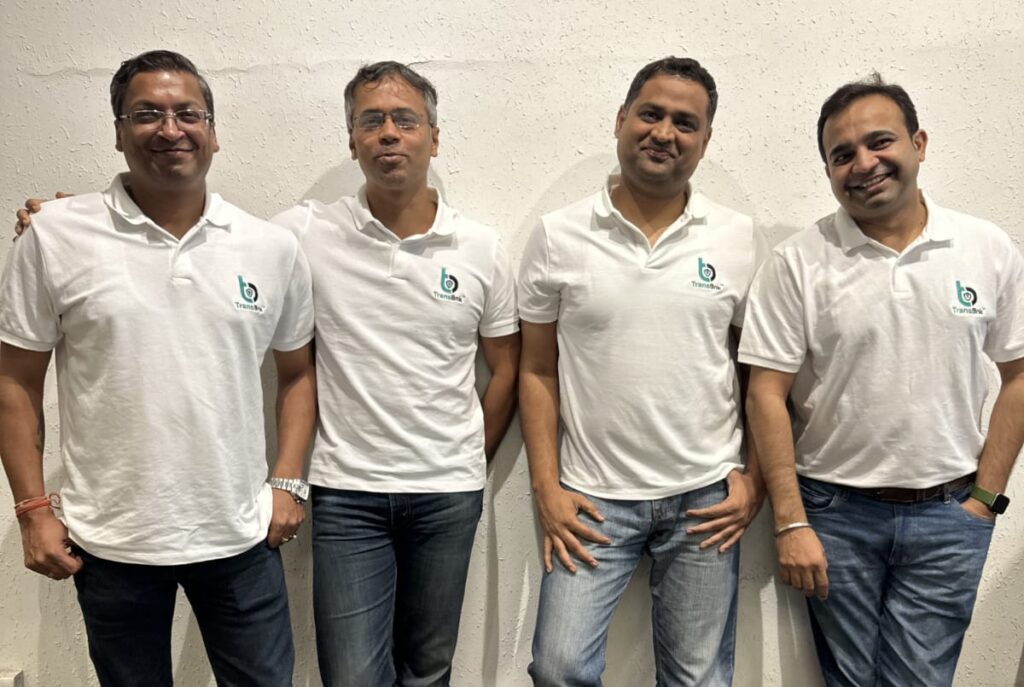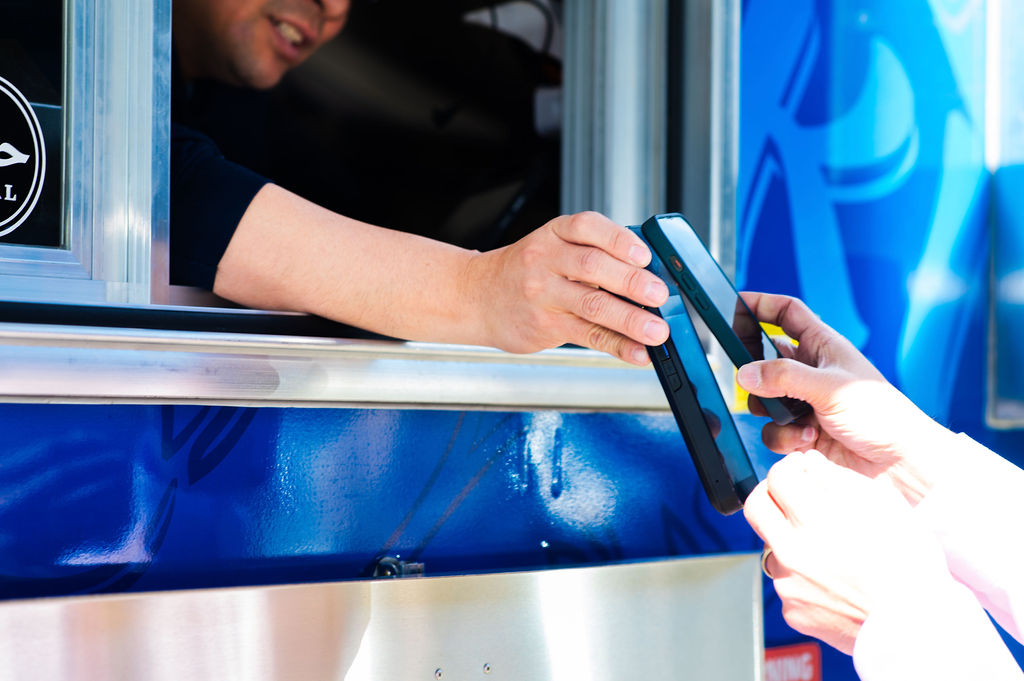
Michael Wolfe contributed to this article.
In part one of Accion Venture Lab’s series on building successful vertical SaaS companies, we honed in on the five metrics that matter for a verticalized SaaS business. These “north star” metrics are what investors utilize to determine not just the operational health of a company, but whether they are building the right approach to long-term growth. Here’s a helpful recap that sums up those metrics:
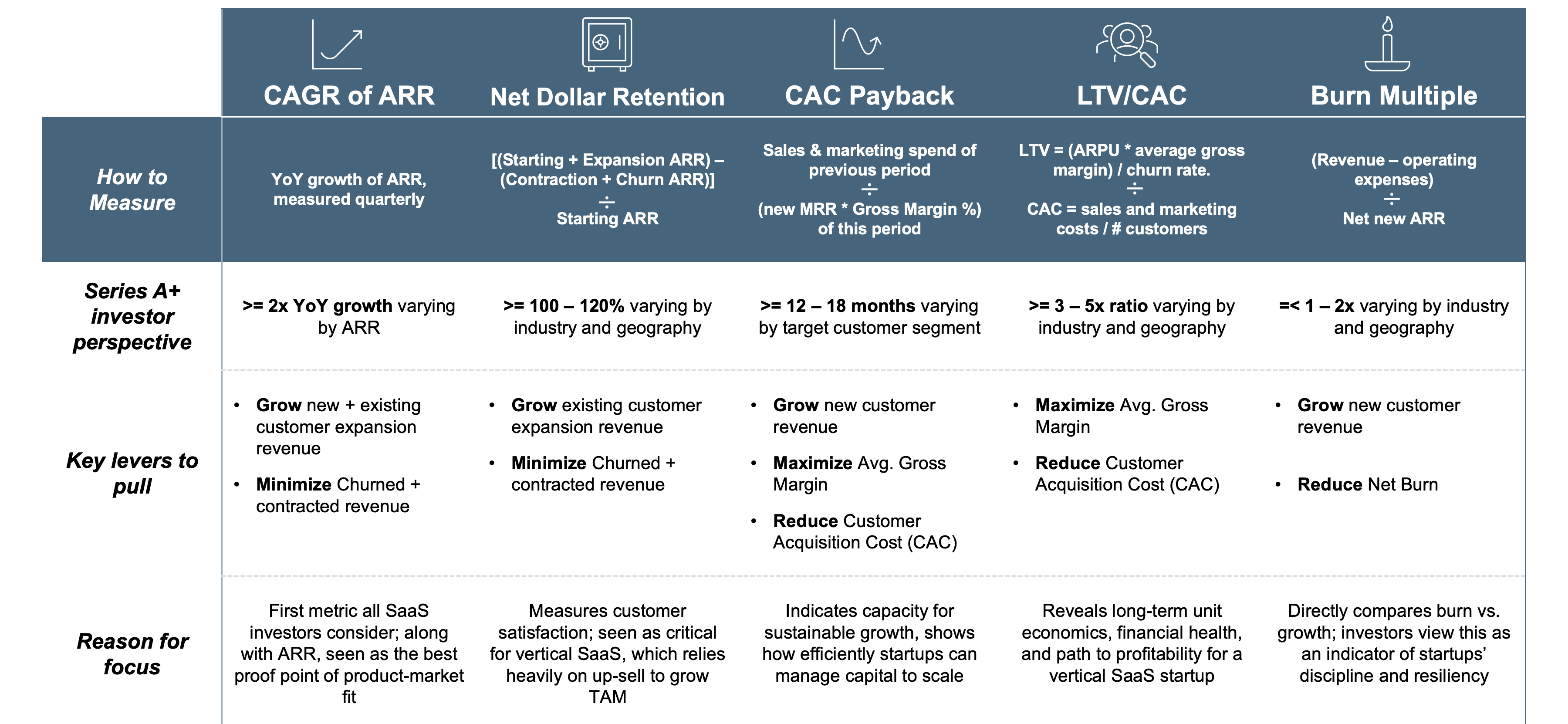
Here, in part two of our series, we’ll address the question on everyone’s mind: What can founders do to improve those metrics? We’ll walk through some of the empirical examples that successful verticalized SaaS companies have used in the past, giving a nod to a central character in each: finding ways to incorporate embedded financial services into each model to drive customer growth, retention, and long-term value.
There is notable overlap in how to improve these metrics; you can ostensibly improve CAGR and NDR through a focus on expansion ARR, for example. Using examples of successful vSaaS companies, we identified four core methods that have a marked influence on the metrics that matter: Acquiring new customers quickly, increasing ARPU for existing customers, preventing churn, and building a capital-efficient sales engine. The summary of how each of these actions affects the respective metrics we outlined in part one is highlighted below.
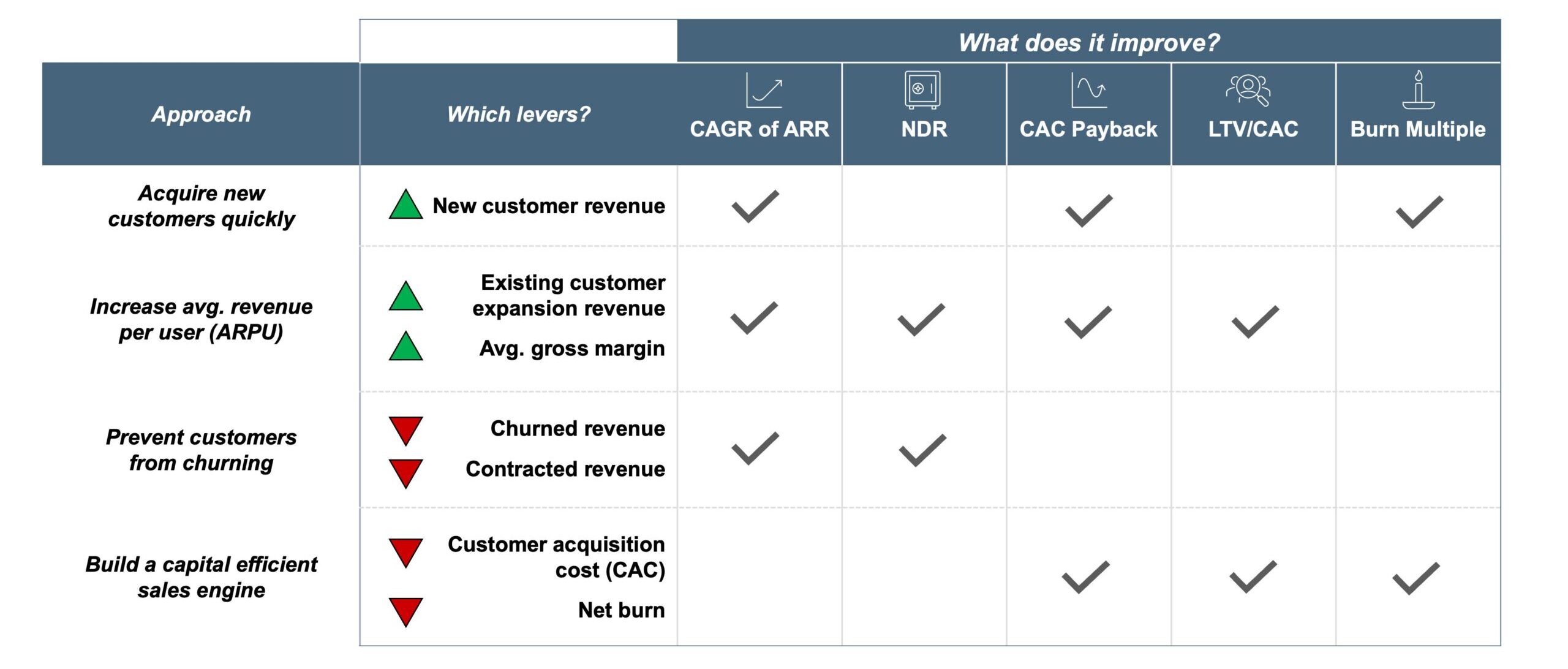
With the stage set, let’s dive into some specific approaches a startup can undertake within each of these methods.
1. Acquire new customers quickly
Approach #1: Clearly define ideal customer personas (ICP) and match your go-to-market to your personas
In the quest for rapid customer acquisition, startups must meticulously define ideal customer personas (ICPs) and align their go-to-market strategies accordingly. High-potential sub-segments within industry verticals, referred to as “sub-verticals,” offer fertile ground for acquisition. These sub-verticals, characterized by their size and penetrability, present ample opportunities for market share capture. By focusing on a sub-vertical, a company can laser-focus their go-to-market plans and develop extraordinarily successful market capture.
Toast adopted this strategy early in their journey: they quickly discovered that focusing on restaurants with fewer than two “doors” (a.k.a. locations) enabled them to quickly close deals and build customer affinity. They built their go-to-market plan around this ICP in very focused ways, even setting a revenue cap for an ideal customer. Due to their sharp focus on customer definition, Toast was able to allocate resources only on their ICPs, convert them faster, and experience a notable acceleration in customer growth in advance of their 2021 IPO.
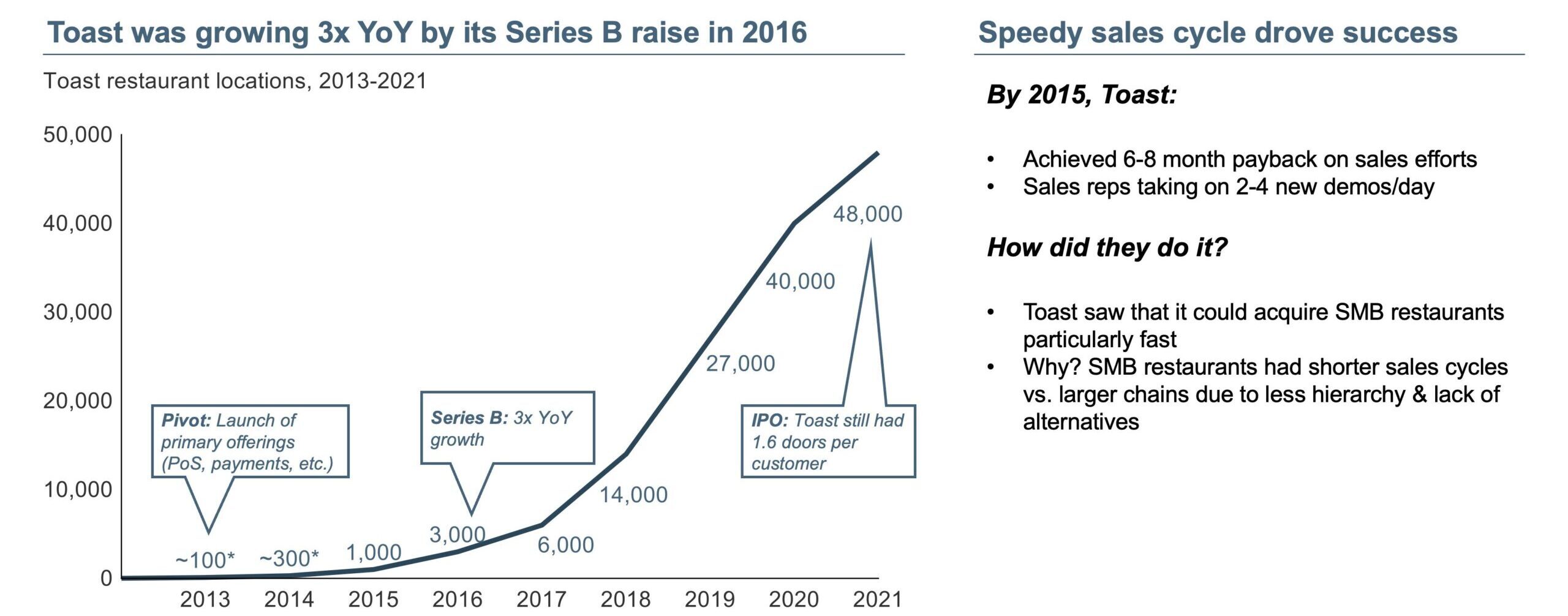
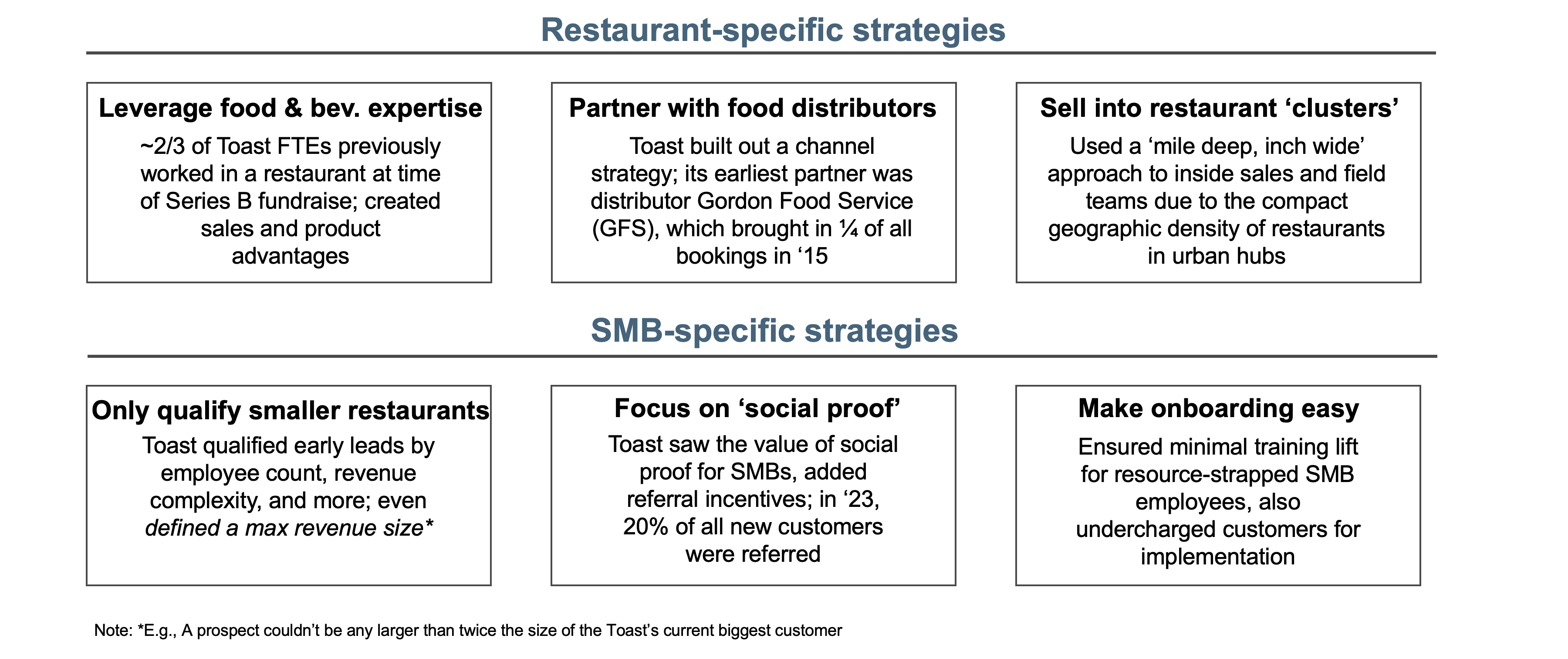
Note: *Estimates via BVP growth data; 2011, 2012 data excluded due to business model pivot; figures rounded to nearest hundred; 1Doors = locations
Approach #2: Experiment with growth-oriented product and pricing models
Embracing innovation in product development and pricing models is essential for accelerating customer acquisition. Startups can match market demand by embedding proven fintech and marketplace integrations. By offering such hook products at competitive price points and enhancing the product’s value proposition, startups can expedite sales funnel conversions. Additionally, we’ve seen multiple examples where a SaaS introduces a more flexible, “baseline” subscription for their SaaS product when a customer chooses to adopt added product features – including some kind of embedded finance.
Silo adopted this strategy in a demonstrative way: They provided their SaaS platform to food distributors for free, increasing usage and stickiness while capturing revenue through collections and payment processing. After a subsequent fundraise, Silo then partnered with an off-balance sheet lender to offer cash advance solutions to their customers.
2. Increase average revenue per customer (ARPU)
Approach #1: Go multi-product with fintech first
We believe that embedding financial services in vertical software is arguably the best lever to increase ARPU. It provides two key advantages: First, products like payments, lending, and payroll relate to core vertical-specific use cases; second, with the increased availability of turnkey fintech offerings, it is easier than ever for a vSaaS platform to integrate financial services off-the-shelf.
Mindbody experienced success in growing monthly recurring revenue per subscriber through payments. Throughout their lead-up to IPO, payments as a percentage of MRR increased from 20 percent to 33 percent; in addition, payments enabled Mindbody to increase their per-customer MRR by a third.
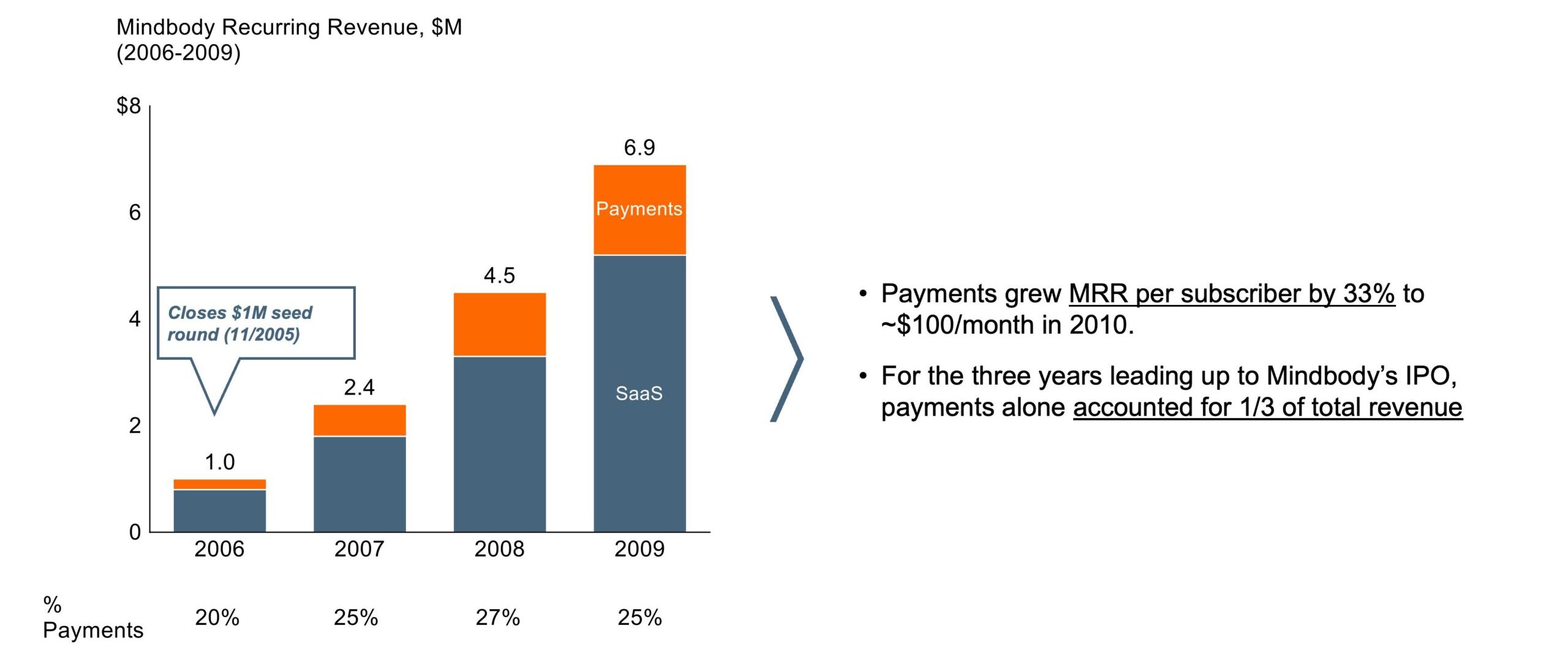
There’s an important question to keep in context here: What fintech products should I offer, and when? We think of four broad categories of products that can be availed through a vSaaS platform: payments, lending, payroll, and banking. Our research suggests that the type of fintech product one should consider depends on customer traits, use cases, and software type. We’ve provided some examples in the chart here:
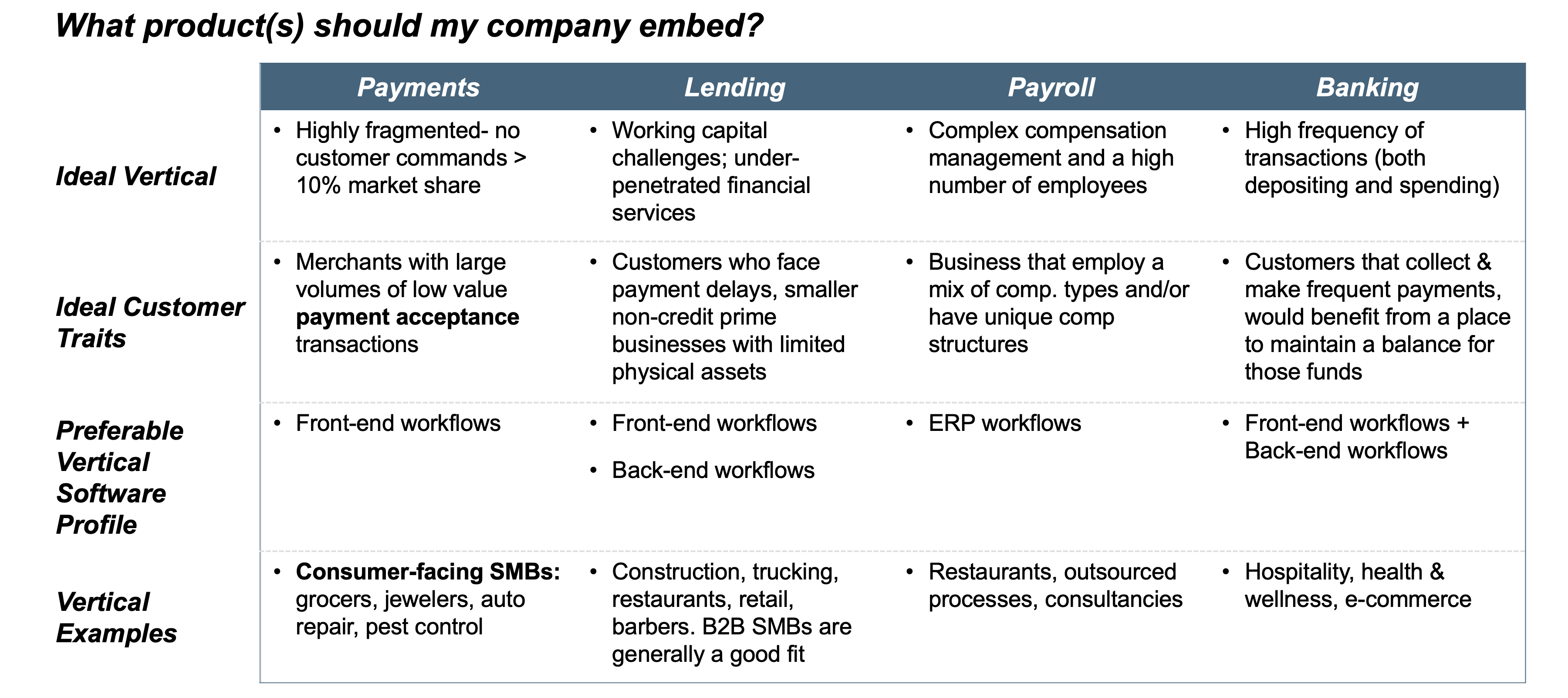
The two most common embedded fintech products are payments and lending, and for several reasons, we see payments as a more suitable solution to deploy first. To start with, payments data can be a powerful tool to improve lending underwriting. Moreover, it’s easy to launch with third-party integrations and offers a frictionless way to build greater customer affinity. A common adage we hear is “payments is the wedge; lending is the wallet grab.”
Approach #2: Sell through your value chain; Fintech can help!
Empowering customers to enhance their revenue streams through value-added services is a potent strategy for augmenting ARPU. ServiceTitan shows us how: Its lending partnerships enable home services companies to offer financing to end customers, exemplify how value chain integration drives revenue growth. By facilitating sales closures and nurturing customer loyalty, ServiceTitan has claimed its on-platform lending has helped its customers grow their businesses by a median of 30 percent.
3. Prevent customers from churning
Approach #1: Invest in post-sales customer experience
Finding ways to keep your customers is simply good business. Not only does it spur on better net dollar retention (NDR), but generally we see that it costs 5 to 25 times more to acquire a new customer than to retain an existing one. Additionally, the time period before time-to-value is reached – the point where a customer starts paying for your service – is often where the most churn occurs. Prioritizing the post-sales customer experience is paramount to reducing churn rates and fostering long-term relationships, as it helps bridge that chasm.
Procore adopted a three-step playbook for reducing time to value, including automation of onboarding processes and certification programs, along with building a set of marketing “drip campaigns” that encouraged continued customer usage of the platform.
Approach #2: Turn your product into a platform
As a startup begins to mature, often after a Series A or later injection of capital, we see successful vSaaS companies start to morph their product into a comprehensive platform. This approach enhances stickiness and reduces the likelihood of churn. By allowing seamless integration with third-party applications and fostering a vibrant developer community, startups can deepen customer engagement and retention.
Procore did this in two ways: First, they opened their API to enable other adjacent platforms to integrate seamlessly with Procore’s workflows. And, once they discovered that customers wanted to use Procore as their platform of choice, they made the integration process even easier by building their own “App Store”, or marketplace where customers could, with one click, integrate other platforms without the use of the API or any code. Today, over 95 percent of Procore customers use at least one integration from their marketplace.

Approach #3: Increase switching costs so it’s harder to dislodge your product
Making a solution indispensable is a challenging thing to do, especially in a competitive environment. However, there are a few methods that a vSaaS can utilize to become more entrenched into a customer’s way of working:
- Capture customer data, define the structure of the data, and build value-added services on that data. By making data more organized, building analytics, or offering other approaches, they can make migration to another platform less appealing. Core Banking Systems are a great example of a data play where switching often means a painful data migration process.
- Land with a “champion” within the organization, then expand by identifying other teams and workstreams within the company where your services would be of benefit. Switching in this case affects multiple teams and thus has more inertia. To give an example from our own portfolio, Licify identifies stakeholders within large construction companies that are known for adopting innovative, technology-centric approaches to project and subcontractor management, then aims to build deeper roots within other aspects of the organization.
- Control the nerve centers, or the key, day to day operations of a customer, and make the experience too delightful to abandon or replace. To give another example from our portfolio, Goodfynd differentiates itself by providing point-of-sale solutions specifically catered to food truck owners, making the experience for that customer more pleasant and trustworthy than their competitors.
4. Build a capital-efficient sales engine
Solution #1: Identify stakeholders across the business who can help build an efficient sales engine
Harnessing internal and external stakeholders to build a capital-efficient sales engine is essential for sustainable growth – and we heard from many later stage investors that this is important during a high-growth, pre-Series A phase. Investors use a variant of the burn multiple called the “Magic Number” to assess a company’s sales engine in isolation.
In order to create efficiency plays, an “all hands on deck” approach is essential. The smartest founders will call on various stakeholders to play a part; strategic investors, channel partners, and specialized sales team structures can all play pivotal roles in optimizing acquisition costs and driving revenue.
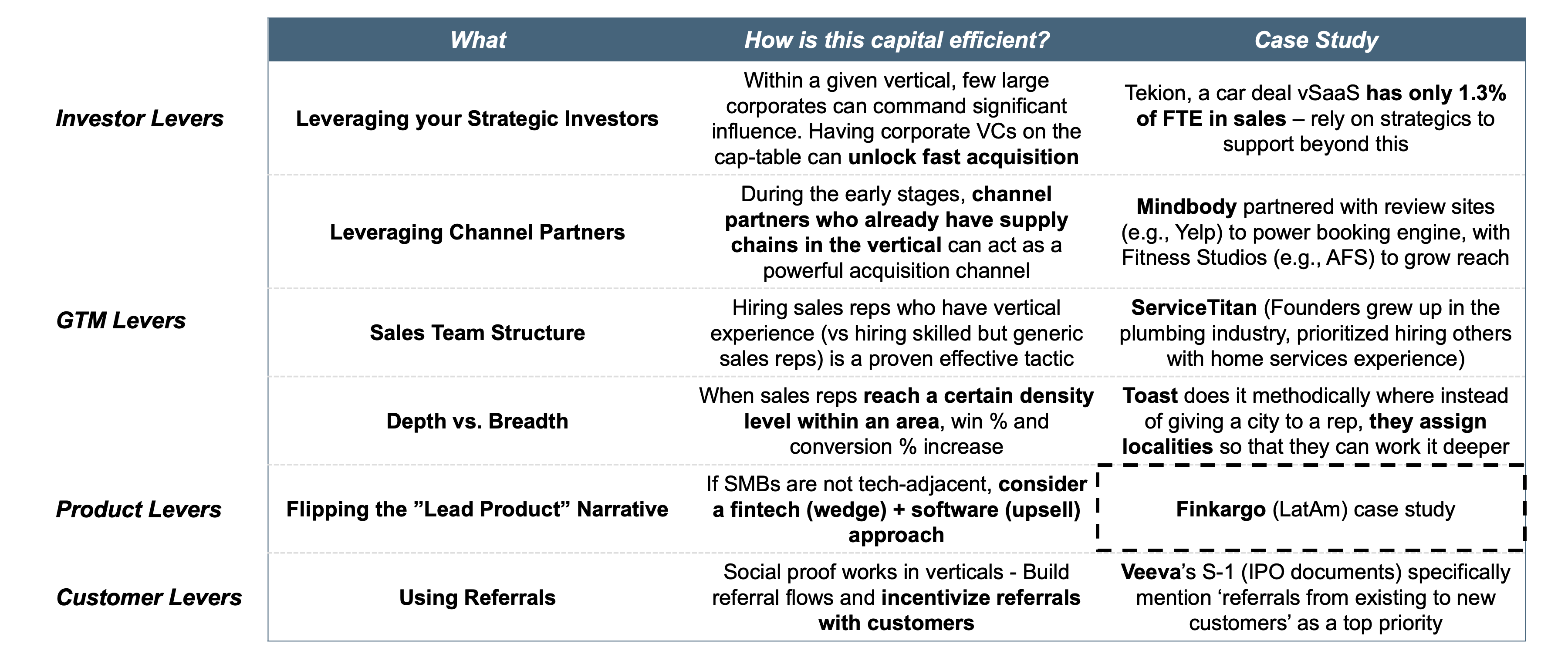
As an example of one of the above approaches, Finkargo, a trade financing platform in Latin America, leveraged their product in a unique way: they discovered that their target customer was not tech savvy, but faced a massive challenge in accessing credit to run their small business. So, they started by offering a financing solution as the hook, achieving product-market fit, and then building a supply chain management SaaS solution. As one of Finkargo’s investors commented, “Finkargo realized that in the long term, software will be the differentiator that will retain customers and thus they wasted no time in introducing SaaS even if it was quite basic and rudimentary.”
Approach #2: Prioritize acquisition (over upsell) during early stage
In markets with high first-mover benefits, new logos are king – so in the nascent stages of growth, startups should prioritize customer acquisition over upselling to capitalize on early-mover advantages. Focusing resources on expanding market reach and establishing product-market fit accelerates revenue growth and market dominance. We see that, for startups with less than $50 million ARR, about 75 percent of a top-performing startup’s gross new ARR distribution is from new logos. As the business grows, and capital efficiency becomes all the more important (remember, it’s 5-25x more expensive to capture a new customer!), a 50-50 split is more common.
We hope these insights have been useful, whether you are an investor, founder, or operator. The world of verticalized SaaS will continue to expand and have outsize effects on the industries they aim to improve. We believe the savviest startups will adhere to the lessons learned in this writing to outshine their competitors and build organizations that last.








